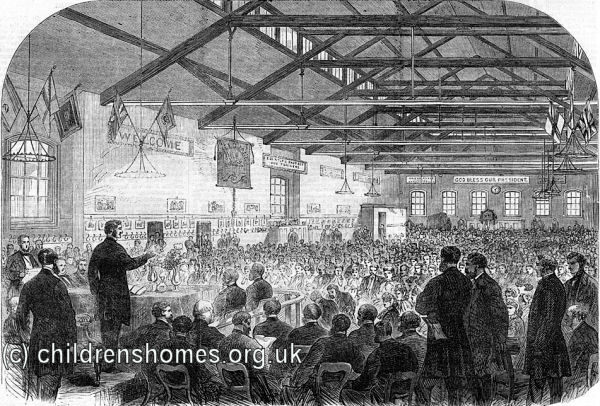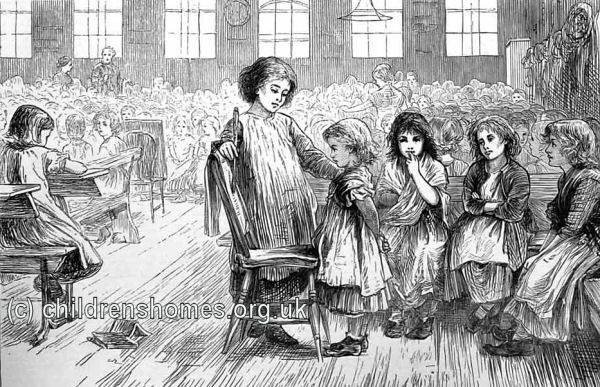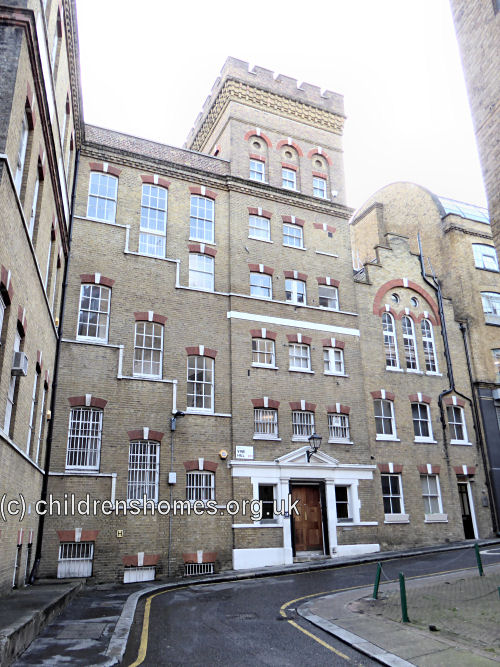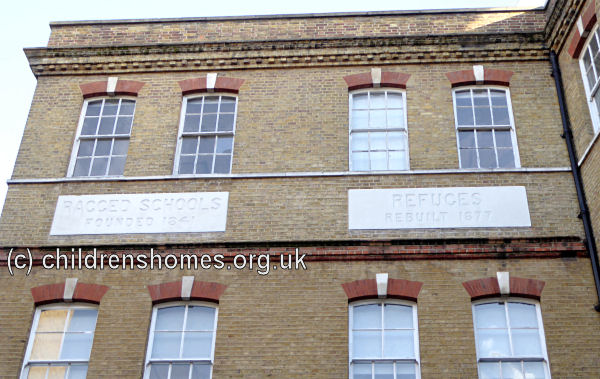Field Lane Ragged and Industrial School, Clerkenwell, London
The Field Lane Ragged School in Clerkenwell was founded in 1841 by Andrew Provan, a missionary who had recently come to work in the area which was one of the most crowded and squalid in London, and the location of many scenes in Charles Dickens' novel Oliver Twist. On the afternoon of Sunday 7th November, 1841, in a small back room in Caroline Court, Provan held the first session of Field Lane Sabbath School, attended by 45 children from the neighbourhood. A few weeks later, the School moved to White's Yard, Saffron Hill, but was met by considerable local hostility, and was subjected to a number of attacks.
In November, 1842, the School took up residence at 65 West Street, West Smithfield. By the end of the year, the School was holding a Sunday morning class with 15 children in attendance, a Sunday afternoon class with up to 60 children, and a similarly sized class on Thursday evenings. class with a similar attendance. The only equipment at the teachers' disposal apart from six chairs and a few forms, were six New Testaments, thirty-six reading books and six hymn books.
In March, 1852, Charles Dickens wrote about visits he had made to the School:
I found my first Ragged School, in an obscure place called West Street, Saffron Hill, pitifully struggling for life, under every disadvantage. It had no means, it had no suitable rooms, it derived no power or protection from being recognized by any authority, it attracted within its wretched walls, a fluctuating swarm of faces — young in years, but youthful in nothing else — that scowled Hope out of countenance. It was held in a low-roofed den, in a sickening atmosphere, in the midst of taint and dirt and pestilence: with all the deadly sins let loose, howling and shrieking at the doors. Zeal did not supply the place of method and training; the teachers knew little of their office; the pupils with an evil sharpness, found them out, got the better of them, derided them, made blasphemous answers to scriptural questions, sang, fought, danced, robbed each other; seemed possessed by legions of devils. The place was stormed and carried, over and over again; the lights were blown out, the books strewn in the gutters, and the female scholars carried off triumphantly to their old wickedness. With no strength in it but its purpose, the school stood it all out, and made its way. Some two years since, I found it, one of many such, in a large convenient loft in this transition part of Farringdon Street quiet and orderly, full, lighted with gas, well whitewashed, numerously attended, and thoroughly established.
Dickens also described the night shelter and industrial school that were subsequently set up as an adjunct to the ragged school.
The number of houseless creatures who resorted to it, and who were necessarily turned out when it was closed, to hide where they could in heaps of moral and physical pollution, filled the managers with pity. To relieve some of the more constant and deserving scholars, they rented a wretched house, where a few common beds — a dozen and a half perhaps — were made upon the floor. This was the Ragged School Dormitory; and when I found the school in Farringdon Street, I found the Dormitory in a court hard by, which in the time of the Cholera had acquired a dismal fame. The Dormitory was, in all respects, save as a small beginning, a very discouraging Institution. The air was bad; the dark and ruinous building, with its small close rooms, was quite unsuited to the purpose; and a general supervision of the sleepers was impossible. I had great doubts at the time whether, excepting that they found a crazy shelter for their heads, they were better there than in the streets.
Having heard, in the course of the last month, that this Dormitory (there were others elsewhere) had grown as the School had grown, I went the other night to make another visit to it. I found the School in the same place, still advancing. It was now an Industrial School too; and besides the men and boys who were learning — some aptly enough; some, with painful difficulty; some, sluggishly and wearily; some, not at all — to read and write and cipher; there were two groups, one of shoemakers, and one (in a gallery) of tailors, working with great industry and satisfaction. Each was taught and superintended by a regular workman engaged for the purpose, who delivered out the necessary means and implements. All were employed in mending, either their own dilapidated clothes or shoes, or the dilapidated clothes or shoes of some of the other pupils. They were of all ages, from young boys to old men. They were quiet, and intent upon their work
In 1843, the School came to the notice Lord Ashley (later the seventh Earl of Shaftesbury) who became a lifelong supporter of the establishment. An article about its work in The Times in 1858, also provided helpful publicity and around £7,000 in donations to its funds. The School's Annual Report for 1858 illustrates the growth in its activities, which now included a free day school.
Mr. Samuel Tawell read the Sixteenth Annual Report, from which it appeared that 314 fresh scholars had been admitted during the year to the Free Day School for infant boys and, girls. The average daily attendance was 345. These children represented 136 families, only four of whom attended places of worship; 23 children were fatherless and motherless, 51 were fatherless and 15 motherless, and 13 quite destitute of homes. The children in this School were taught reading, writing, grammar, and an outline of geography; and the girls, sewing. During the year many of these had made great progress, and had been sent to situations. During the winter months 200 garments had been given away; 81 coal-tickets, for each of which the bolder received 1 cwt. of coals; and 60 poor families received bread for three weeks on payment of 2d. per loaf. During the past year, owing to the exertions of the master, 66 boys and 24 girls had been sent to situations, 32 destitute boys and 21 girls had been got into Refuges, and 32 boys into the Red Brigade Shoe-blacks; 29 were employed as Crossing-sweepers, and 9 restored to their friends, making 203 provided for from this branch of the institution. Eighty-six men and boys attended the Evening School, and 80 a Night School. Although detained from 14 to 16 hours a day at work, they evinced a strong desire for elementary knowledge. The Report also gave a satisfactory account of the working of the Crossing-sweepers, of the Mothers' Class, of the Industrial Class, the Clothing Society, the Male Night Refuge the Female Night Refuge for the Homeless, the Bible School the Women's Bible Class, and the Ragged Church.
When the construction of an approach road to the new Smithfield meat market required the demolition of the School's premises, a site was purchased on Little Saffron Hill on which to erect a new building to house all of its operations. The foundation stone for the new building was laid by Lord Shaftesbury on June 13th, 1865, and the completed structure was opened by him on June 6th, 1866. The building was designed by Mr W. Higgs of Russell Square, with a total cost, including the site, of £18,000. The basement floor contained separate receiving rooms for male and female inmates, with baths and lavatories. There were also separate lavatories heated by steam for the purpose of drying the clothes of those coming in wet, kitchen, together with a food room, laundry and wash- house. The ground floor comprised two refuges for males and females, with separate receiving-rooms for each, 90 feet by 21 feet, with master and matron's rooms adjoining. The first floor included a Bible-class room, dormitories, servants' home, baths and lavatories, committee-room, etc. The second floor housed the main school-room, which measured 90 feet by 42 feet.

Opening of new Field Lane Ragged School premises, Saffron Hill, 1866. © Peter Higginbotham

Girls at Field Lane Ragged School, Saffron Hill, 1871. © Peter Higginbotham
On July 19th, 1870, the part of the premises were certified to operate as an Industrial School, allowing the School to house up to 80 children committed by the courts. A report in 1871 recorded that, in addition to classroom lessons, the boys in this department received industrial training which included tailoring, shoemaking, and wood chopping. The girls were employed in needlework and housework. It was also noted that the ragged school had a daily attendance of 1,000 children The superintendent of the Industrial School was Mr F. Williams, assisted by a schoolmaster (Mr Kirke) and labour-master. Mrs Webb had charge of the girls' school.
In 1872, it was discovered that the construction of the new Clerkenwell Road was going involve the compulsory purchase and demolition of the recently occupied new building and that another move was required. A site was eventually obtained on Vine Street (now Vine Hill) where the foundation stone was laid for a new building on June 13th, 1877. Unfortunately, the School was required to vacate the Little Saffron Hill site before the new premises were completed and had to operate for a year in temporary accommodation on Wilderness Row.

Field Lane Ragged School and Night Refuge, Vine Street, c.1880. © Peter Higginbotham

Assembly hall at Field Lane Ragged School and Night Refuge, Vine Street, c.1880. © Peter Higginbotham
The decision was also made to move the Industrial Schools out of central London and to open separate establishments for the boys and girls. In 1876, the girls moved to premises on Church Row, Hampstead recently vacated by the Hampstead Girls' Reformatory. For the boys, a new building was erected at Hillfield Road, West Hampstead. However, as this was not ready for occupation until 1878, the boys' Industrial School took up temporary residence in part of the Wilderness Row accommodation.

Former Field Lane Ragged School and Night Refuge, Vine Hill, London, 2018. © Peter Higginbotham

Former Field Lane Ragged School and Night Refuge, Vine Hill, London, 2018. © Peter Higginbotham
The institution founded by Andrew Provan is now known simply as Field Lane and continues to provide care and support for people who are frail or who have learning disabilities.
Records
Note: many repositories impose a closure period of up to 100 years for records identifying individuals. Before travelling a long distance, always check that the records you want to consult will be available.
- The
Ancestry UK
website has two collections of London workhouse records (both name searchable):
- The Find My Past website has workhouse / poor law records for Westminster.
- London Metropolitan Archives, 40 Northampton Road, London EC1R OHB.
Bibliography
- Higginbotham, Peter Children's Homes: A History of Institutional Care for Britain's Young (2017, Pen & Sword)
- Mahood, Linda Policing Gender, Class and Family: Britain, 1850-1940 (1995, Univeristy of Alberta Press)
- Prahms, Wendy Newcastle Ragged and Industrial School (2006, The History Press)
Links
- Field Lane website
- None noted at present.
Except where indicated, this page () © Peter Higginbotham. Contents may not be reproduced without permission.


